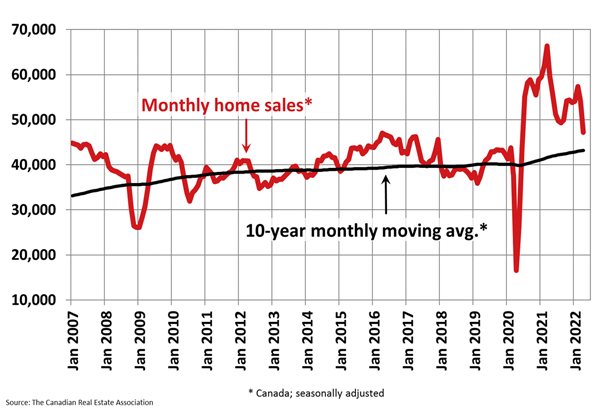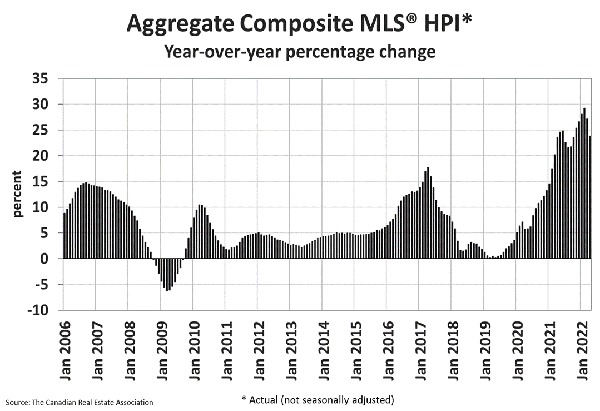OTTAWA, Ontario, Tuesday May 17, 2022 — Statistics released, yesterday, by the Canadian Real Estate Association (CREA) show national home sales declined by 12.6 percent, last month.
The decrease placed monthly house sales activity at the lowest level since the summer of 2020.
While the national decline was led by the Greater Toronto Area (GTA) simply because of its size, sales were down in 80 percent of local markets, with most other large markets posting double-digit, month-over-month declines in April.
The exceptions were Victoria, Montreal and Halifax-Dartmouth, where sales edged up slightly.
The actual — not seasonally adjusted — number of transactions in April 2022 came in 25.7 percent below the record for that month set last year; and, as has been the case since last summer, it was still the third-highest April sales figure ever, behind 2021 and 2016.
“Following a record-breaking couple of years, housing markets in many parts of Canada have cooled off, pretty sharply, over the last two months, in line with a jump in interest rates and buyer fatigue,” said Jill Oudil, Chair of CREA.
“For buyers, this slowdown could mean more time to consider options in the market. For sellers, it could necessitate a return to more traditional marketing strategies.”
 Shaun Cathcart, CREA’s Senior Economist stated, “After 12 years of ‘higher interest rates are just around the corner’ here they are, but it’s less about what the Bank of Canada has done so far. It’s about a pretty steep pace of continued tightening that markets expect to play out, over the balance of the year, because that is already being factored into fixed mortgage rates.
Shaun Cathcart, CREA’s Senior Economist stated, “After 12 years of ‘higher interest rates are just around the corner’ here they are, but it’s less about what the Bank of Canada has done so far. It’s about a pretty steep pace of continued tightening that markets expect to play out, over the balance of the year, because that is already being factored into fixed mortgage rates.
“Of course, those have, for that very reason, been on the rise since the beginning of 2021, so why the big market reaction only now? It’s likely because typical discounted 5-year fixed rates have, in the space of a month, gone from the low 3 percent range to the low 4 percent range.”
He continued, “The stress test is the higher of 5.25 percent or the contract rate plus 2 percent. For fixed borrowers, the stress test has just moved from 5.25 percent to the low 6 percent range – close to a 1 percent increase in a month! It won’t take much more movement by the Bank of Canada for this to start to affect the variable space as well.”
The number of newly-listed homes edged back by 2.2 percent, on a month-over-month basis, in April. The small monthly decline was the result of a fairly even split, between markets, where listings rose and those where they fell. Notable declines were seen in the Lower Mainland and Calgary, while listings jumped higher in Victoria and Edmonton.
With sales falling by quite a bit more than new listings in April, the sales-to-new listings ratio eased back to 66.5 percent – its lowest level since June 2020. This reading is right on the border between what would constitute a seller’s and a balanced market. The long-term average for the national sales-to-new listings ratio is 55.2 percent.
A little more than half of local markets were balanced markets, based on the sales-to-new listings ratio being between one standard deviation above or below the long-term average in April 2022. A little less than half were in seller’s market territory.
There were 2.2 months of inventory on a national basis at the end of April 2022, still historically very low, but up from slightly lower readings in the previous eight months. The long-term average for this measure is a little over 5 months.
 Home prices edged down 0.6 percent, on a month-over-month basis, last month – the first month-over-month decline since April 2020. Regionally, most of the monthly declines were seen in markets in Ontario, although many Ontario markets were also up, while some others were flat.
Home prices edged down 0.6 percent, on a month-over-month basis, last month – the first month-over-month decline since April 2020. Regionally, most of the monthly declines were seen in markets in Ontario, although many Ontario markets were also up, while some others were flat.
Prices climbed modestly across the Prairies in April, while price growth remained robust in Eastern Canada.
The non-seasonally adjusted average price was still up by 23.8 percent, on a year-over-year basis, in April, although this was a marked slowdown from the near-30 percent record increase, logged just two months earlier.
The actual (not seasonally adjusted) national average home price was a little over $746,000 in April, up 7.4 percent from the same month last year. The national average price is heavily influenced by sales in Greater Vancouver and the GTA, two of Canada’s most active and expensive housing markets.
Excluding these two markets from the calculation, last month, cuts $138,000 from the national average price.
 Pride News Canada's Leader In African Canadian & Caribbean News, Views & Lifestyle
Pride News Canada's Leader In African Canadian & Caribbean News, Views & Lifestyle





